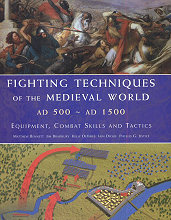
Fighting techniques of the medieval world (fülszöveg)
Fighting Techniques of the Medieval World describes the combat methods of soldiers in Europe and the Near East in the age before the widespread use of gunpowder. The book explores the unique tactics required to win battles with the technology available, and demonstrates how little has changed in some respects in the art of war.
The book is divided into five chapters covering the main elements of medieval warfare: infantry, cavalry, generalship, siege warfare and naval combat. Each chapter features four major battles to demonstrate the strengths, pitfalls and characteristics of the style of warfare. In the first chapter, the book explores the role of infantry by examining the battles of Casilinum (554), Arsuf (1191), Bannockburn (1314) and Agincourt (1415). The uses of light infantry, huscarls, archers and pikemen are discussed, and the development of technological innovations – such as the introduction of cannon and arquebus in the fifteenth century – are explored. The second chapter examines the importance of cavalry, their role as the shock troops of the era, and their decline in significance with the development of both disciplined pike formations and the increasing importance of musket on the battlefield. The third chapter discusses how these units were used together on the battlefield, how commanders controlled their men in the heat of battle and the importance of a general effectively deploying his troops before the fighting began. The fourth chapter looks at the specialist techniques and equipment developed for siege warfare, with examples of classic battles such as the successful Turkish assault on Constantinople (1453). The final chapter looks at the role of naval warfare, examining the development of ships as floating platforms for infantry to the introduction of naval cannon.
Using specially-commissioned colour and black-and-white artworks to illustrate the battles, equipment and tactics of the era, Fighting Techniques of the Medieval World shows in detail the methods by which armies, including Norman, Crusader and Mongol forces, prevailed over their foes, and why other armies were less successful. The book is an essential companion for any reader interested in warfare in the medieval age.